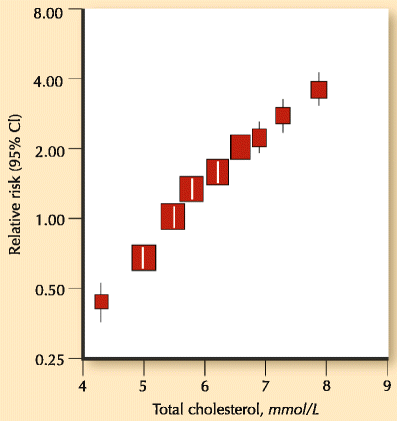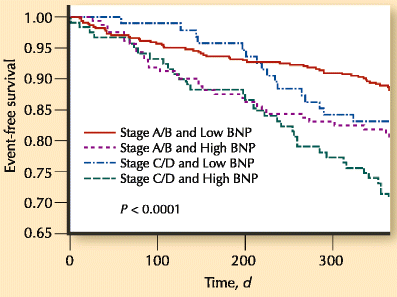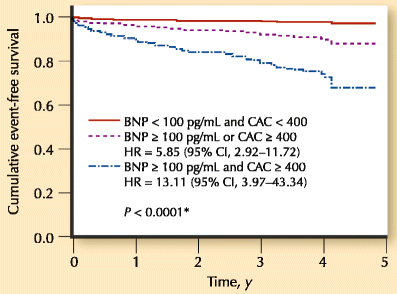Natriuretic Peptides and Assessment of Cardiovascular Disease Risk in Asymptomatic Persons
- PMID: 20672100
- PMCID: PMC2894089
- DOI: 10.1007/s12170-010-0078-8
Natriuretic Peptides and Assessment of Cardiovascular Disease Risk in Asymptomatic Persons
Abstract
Current tools for cardiovascular disease (CVD) risk assessment in asymptomatic individuals are imperfect. Preventive measures aimed only at individuals deemed high risk by current algorithms neglect large numbers of low-risk and intermediate-risk individuals who are destined to develop CVD and who would benefit from early and aggressive treatment. Natriuretic peptides have the potential both to identify individuals at risk for future cardiovascular events and to help detect subclinical CVD. Choosing the appropriate subpopulation to target for natriuretic peptide testing will help maximize the performance and the cost effectiveness. The combined use of multiple risk markers, including biomarkers, genetic testing, and imaging or other noninvasive measures of risk, offers promise for further refining risk assessment algorithms. Recent studies have highlighted the utility of natriuretic peptides for preoperative risk stratification; however, cost effectiveness and outcomes studies are needed to affirm this and other uses of natriuretic peptides for cardiovascular risk assessment in asymptomatic individuals.
Figures



Similar articles
-
Natriuretic peptide-guided treatment for the prevention of cardiovascular events in patients without heart failure.Cochrane Database Syst Rev. 2019 Oct 15;10(10):CD013015. doi: 10.1002/14651858.CD013015.pub2. Cochrane Database Syst Rev. 2019. PMID: 31613983 Free PMC article. Review.
-
Cardiac risk scores in high-risk Hispanics and the predictive value of BNP.J Clin Nurs. 2011 Nov;20(21-22):3039-46. doi: 10.1111/j.1365-2702.2010.03661.x. Epub 2011 May 18. J Clin Nurs. 2011. PMID: 21592244
-
From vulnerable plaque to vulnerable patient--Part III: Executive summary of the Screening for Heart Attack Prevention and Education (SHAPE) Task Force report.Am J Cardiol. 2006 Jul 17;98(2A):2H-15H. doi: 10.1016/j.amjcard.2006.03.002. Epub 2006 Jun 12. Am J Cardiol. 2006. PMID: 16843744 Review.
-
Role of Cardiac Biomarkers in Epidemiology and Risk Outcomes.Clin Chem. 2021 Jan 8;67(1):96-106. doi: 10.1093/clinchem/hvaa228. Clin Chem. 2021. PMID: 33225348 Review.
-
Coronavirus disease 2019 in patients with cardiovascular disease: clinical features and implications on cardiac biomarkers assessment.J Cardiovasc Med (Hagerstown). 2021 Nov 1;22(11):832-839. doi: 10.2459/JCM.0000000000001252. J Cardiovasc Med (Hagerstown). 2021. PMID: 34482324
Cited by
-
Cardiovascular Pleiotropic Effects of Natriuretic Peptides.Int J Mol Sci. 2019 Aug 8;20(16):3874. doi: 10.3390/ijms20163874. Int J Mol Sci. 2019. PMID: 31398927 Free PMC article. Review.
-
Natriuretic peptides in cardiovascular diseases: current use and perspectives.Eur Heart J. 2014 Feb;35(7):419-25. doi: 10.1093/eurheartj/eht466. Epub 2013 Nov 13. Eur Heart J. 2014. PMID: 24227810 Free PMC article. Review.
-
Current Understanding of the Compensatory Actions of Cardiac Natriuretic Peptides in Cardiac Failure: A Clinical Perspective.Card Fail Rev. 2016 May;2(1):14-19. doi: 10.15420/cfr.2016:4:2. Card Fail Rev. 2016. PMID: 28848655 Free PMC article.
-
B-type natriuretic peptide-guided therapy for perioperative medicine?Open Heart. 2014 Aug 5;1(1):e000105. doi: 10.1136/openhrt-2014-000105. eCollection 2014. Open Heart. 2014. PMID: 25332815 Free PMC article.
References
-
- Pearson TA, Blair SN, Daniels SR, et al. AHA Guidelines for Primary Prevention of Cardiovascular Disease and Stroke: 2002 Update: Consensus Panel Guide to Comprehensive Risk Reduction for Adult Patients Without Coronary or Other Atherosclerotic Vascular Diseases. American Heart Association Science Advisory and Coordinating Committee. Circulation. 2002;106:388–391. doi: 10.1161/01.CIR.0000020190.45892.75. - DOI - PubMed
-
- Vasan RS, Sullivan LM, Wilson PW, et al.: Relative importance of borderline and elevated levels of coronary heart disease risk factors. Ann Intern Med 2005, 142:393–402. (Published erratum appears in Ann Intern Med 2005, 142:681.) - PubMed
